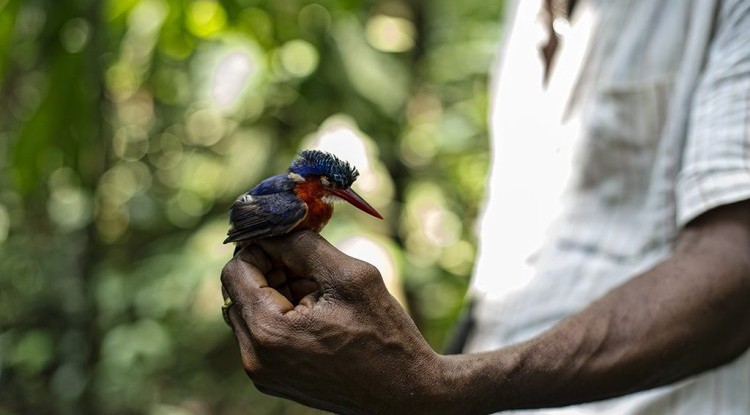
More than 1000 bird species have been identified in the Democratic Republic of Congo – but scientists are still a long way from describing the full biodiversity of the Congo Basin. Ollivier Girard/CIFOR
The pulse in the heart of Africa: The Congo Basin contains the second largest expanse of tropical forest in the world, covering 200 million hectares and spanning six countries. These forests support the livelihoods of 60 million people, generate income from timber exploitation, store huge amounts of carbon, comprise a unique biodiversity and regulate the flow of the major rivers across Central Africa. From the world’s largest swamps, to the mountainous regions in Cameroon and Eastern Democratic of the Congo, these diverse ecosystems support the people and wildlife found in the very heart of Africa.
A meaty issue: hunting for food in the Congo: In rural areas of the Congo Basin many communities depend on wild meat hunted in forests for up to 80% of the fat and protein in their diets. While over-harvesting and dwindling forests mean that current practices are increasingly unsustainable, banning such practices could lead to increased deforestation: for example, by clearing forest for pasture. A ban on the hunting of vulnerable species – like gorillas and elephants – while allowing people to hunt more resilient species, like duikers (small antelopes) and porcupines could be more effective.
Valuing the fruits, nuts and plants of the Congo Basin: NTFPs (non timber forest products), play a vital role in supporting rural and urban livelihoods. Their collection and sale contribute to food security, health, income generation and employment in the Congo Basin. The sale of NTFPs contributes, on average, to 25 to 40 % of household income and women are largely involved in the collection of fuelwood, Gnetum spp. and safou. However, much more research is needed to tailor strategies for sustainable management, starting with a definition and value of NTFPs, and a prioritisation of which ones need to be better monitored and managed.
Domestic timber trade: the impact of chain saw milling: Large-scale industrial timber production accounts for only 3% of global tropical timber production and its impacts are generally well documented. Conversely, the impacts of small-scale chainsaw milling (the on-site conversion of logs into lumber) on trade and on forests are less well known. In Cameroon, the domestic informal timber market is as large as the industrial export-oriented one. While the small-scale sector provides jobs and supports livelihoods, the lack of clear and well-adapted legislation can provide a fertile ground for corruption. Forest certification schemes and new legislation are encouraging smallholders to carry out sustainable practices, but policy change is needed to improve governance and bring informal markets inside the law.
Charcoal: fuelling the economy or deforestation? Fuelwood and charcoal represent 90% of all wood removal from forests in Africa and a third of the global wood fuel production. While Charcoal production increases deforestation and degradation particularly in heavily populated areas, it provides 83% of rural households in Sub-Saharan Africa with a renewable energy source for cooking, as well as income generating activities. Developing forest plantations for wood energy, developing sustainable management of forests, and improving energy processing could help balance its impact on forests.
The Congo Basin Forests: protecting people in a changing climate. The forests of the Congo Basin have enormous potential for helping adapt to and mitigate the impacts of climate change. Constituting 18 percent of the world’s tropical forests and locking away between 25 and 30 billion tonnes of carbon, the forests of the Congo Basin are of huge global significance to schemes that aim to reduce emissions from deforestation or degradation, such as REDD+. These forests also provide safety nets for millions of people, especially women, who are highly dependent on climate-sensitive sectors like agriculture, fisheries, pastoral practices, and whose livelihoods may be threatened by changing weather patterns and resource scarcity.
Where have all the forestry experts gone? The lack of up-to-date and accurate information on the current state and evolution of forested areas in Central Africa is often seen as a limiting factor in the design of efficient forest management policies. Decades of war, underdevelopment and a lack of infrastructure and resources, have also hampered innovation and research in the sector. Much more effort is needed to improve regional and national capabilities and train new experts in forestry management to ensure that forests are protected in the future.
This issue will be one of the topics of discussion at the two-day conference Sustainable forest management in Central Africa: Yesterday, today and tomorrow Yaounde, Cameroon. 22-23 May, 2013.
For CIFOR’s special feature on Central Africa’s forests, visit forestsnews.cifor.org/yaounde
We want you to share Forests News content, which is licensed under Creative Commons Attribution-NonCommercial-ShareAlike 4.0 International (CC BY-NC-SA 4.0). This means you are free to redistribute our material for non-commercial purposes. All we ask is that you give Forests News appropriate credit and link to the original Forests News content, indicate if changes were made, and distribute your contributions under the same Creative Commons license. You must notify Forests News if you repost, reprint or reuse our materials by contacting forestsnews@cifor-icraf.org.
